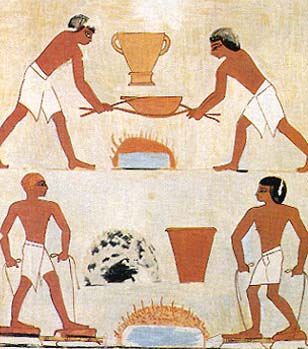Image Details

The Metropolitan Museum of Art, Rogers Fund, 1931
Each hearth has a light blue center, representing either ashes or a floor of clay or stone. The two figures above remove a clay crucible of molten metal from the hearth. The vase above them may contain a copper/tin mixture or water to douse the hot lifting rods.
Between the two lower figures are a vase and a pile of charcoal. The men use foot bellows to direct a forced draft of air onto the hearth in order to increase the intensity of the fire. Although this technique has now been studied in some detail, the best description of it is still that of Norman de Garis Davies (The Tomb of Rekhmire at Thebes, 1943): “The hearth, when in use, was fed with air from two pairs of bellows, each of which was operated by a man who threw his weight from one bag to the other. When he stepped off a depressed bag he raised its upper side by means of a string, and while it was filling again he was deflating its fellow. The air from the bag under pressure was discharged into the heart of the fire through a pipe of reed, ending near the fire in a pottery nozzle [tuyere]. The bellows consisted of a red leather bag mounted on a white object of the same size and shape, which may be a flat stone or another bag. … No valve is shown, but air may have entered through a hole which the operator closed with his heel. The upper bag was tied horizontally round the middle with cord to enable it to stand the distension better.”
